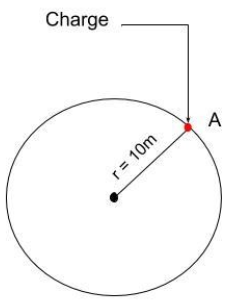Answer
37.2k+ views
Hint: To solve this particular question one must have a clear idea about the concept of the relationship between potential difference, charge and work done. It is a known fact that the potential difference between two points or terminals is the work required in Joules to move one Coulomb of charge.
Complete step by step solution:
It is given that the magnitude of charge is 10 units and it lies at the center of a circle whose radius is 10m. Now suppose this charge follows the circular path starting from point A as shown in the following figure.

We know that the potential difference between any two points is the work done to move a charge between these two points. So the mathematical relation between voltage or potential difference is given below.
$V = \dfrac{W}{Q}$
Where, V is the voltage, W is the work required to move the charge, and Q is the charge to be moved. Hence, the work done is given by,
$W = VQ$……(1)
Now as we know while travelling in a circular path to traverse the path once, the charge will start from point A and will also end at point A. Since the start and end point is one and the same, so the potential difference will be zero (V = 0). Hence, from equation (1) the work done will become, zero. i.e option a is the correct answer.
Note: One volt of potential difference is obtained when 1 joule of work is done on a charge of one coulomb $1Volt = \dfrac{{1Joule}}{{1Coulomb}}$, i.e 1V= 1 J/C. Work done in moving a charge between any point in an electric field is independent of the path followed by the charge between the two points.
Complete step by step solution:
It is given that the magnitude of charge is 10 units and it lies at the center of a circle whose radius is 10m. Now suppose this charge follows the circular path starting from point A as shown in the following figure.

We know that the potential difference between any two points is the work done to move a charge between these two points. So the mathematical relation between voltage or potential difference is given below.
$V = \dfrac{W}{Q}$
Where, V is the voltage, W is the work required to move the charge, and Q is the charge to be moved. Hence, the work done is given by,
$W = VQ$……(1)
Now as we know while travelling in a circular path to traverse the path once, the charge will start from point A and will also end at point A. Since the start and end point is one and the same, so the potential difference will be zero (V = 0). Hence, from equation (1) the work done will become, zero. i.e option a is the correct answer.
Note: One volt of potential difference is obtained when 1 joule of work is done on a charge of one coulomb $1Volt = \dfrac{{1Joule}}{{1Coulomb}}$, i.e 1V= 1 J/C. Work done in moving a charge between any point in an electric field is independent of the path followed by the charge between the two points.
Recently Updated Pages
To get a maximum current in an external resistance class 1 physics JEE_Main

f a body travels with constant acceleration which of class 1 physics JEE_Main

A hollow sphere of mass M and radius R is rotating class 1 physics JEE_Main

If the beams of electrons and protons move parallel class 1 physics JEE_Main

Two radioactive nuclei P and Q in a given sample decay class 1 physics JEE_Main

If a wire of resistance R is stretched to double of class 12 physics JEE_Main

Other Pages
A convex lens is dipped in a liquid whose refractive class 12 physics JEE_Main

Differentiate between homogeneous and heterogeneous class 12 chemistry JEE_Main

Explain the construction and working of a GeigerMuller class 12 physics JEE_Main

In the given circuit the current through the 5mH inductor class 12 physics JEE_Main

Formula for number of images formed by two plane mirrors class 12 physics JEE_Main

Identify which of the above shown graphs represent class 12 physics JEE_Main



